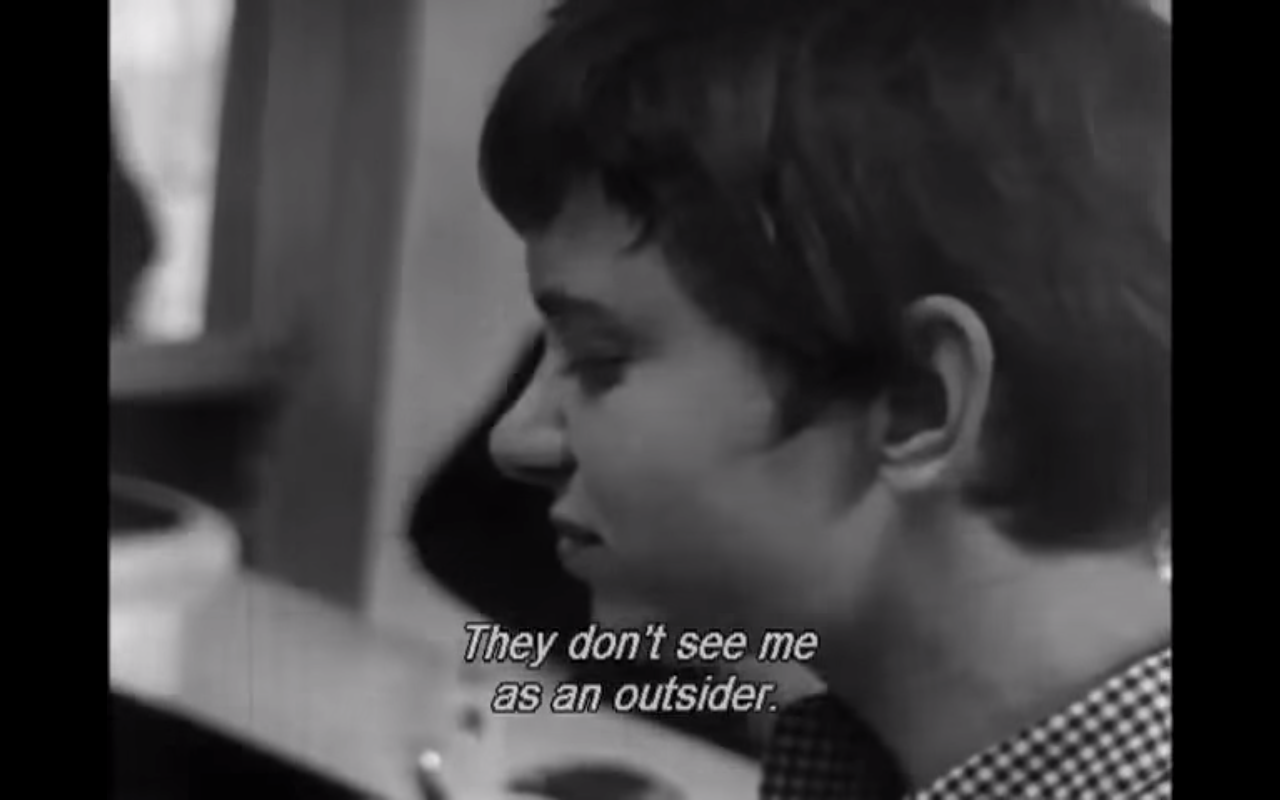Eric Rohmer’s 1964 film, Nadja à Paris, follows a Nadja Tesich through the city. Tesich is an exchange student at the Sorbonne, living at the Cité Universitaire at the southern edge of the city. The film is short—just ten minutes. There is no plot; Nadja leads Rohmer, he in observation of her movement through the city. Nadja narrates the film in a voice-over. The film treats Nadja’s position as a habitual stranger, a regular foreigner. She is not French, nor does she desire to be. She learns the habits and patterns of the city and participates in them as she is: a Yugoslavian-American studying in a city that is not her own. The habits she adopts fixate on two spaces, le terrace and le comptoir.
About three minutes in, she walks through Saint-Germain-des-Pres. It is a familiar view of Paris: old antique shops, book stores, navy blue and white street signs, café tables. Nadja passes un terrace de café. Tables and chairs line the exterior of the café. An assortment of people sit around, talking, reading, drinking. The chairs face outward, towards the street. Nadja sits down at an empty table. No one offers her a table or drops off a menu. The waiter comes, weaving through passers-by, and delivers her drink.
Her narration says: “The French love to linger for hours. I only sit for a while. I have no specific aim. I just sit . . . I observe.” More than a place built for eating or drinking, the terrace describes a kind of social life. The café table, here au terrace, later inside, allows Nadja that particular position as a regular foreigner.
Later in the film, she walks up to the bar at a place called Chez Mimi in Belleville, the working-class neighborhood in eastern Paris. The door is open and light fills the room. The room is full of men: some younger, some older, all workers. She is the only woman in the crowd, and likely the only foreigner.
Nadja stands au comptoir and says, simply: “a glass of red.”
The woman behind the bar fills her glass from an unmarked bottle. Nadja takes a sip. In a brilliant moment, the film cuts to a shot with the camera behind her: we catch the back of her head as she brings the glass to her mouth and the man to her left doing exactly the same. That shot speaks volumes: here, au comptoir, a man and a woman from wholly different places do the same thing. He looks over the rim of his glass and says: “That’s no good. Bad for the liver. You shouldn’t drink that.” He points out their mirror in a friendly mockery. Nadja responds, “I’m used to it.” She is used to the wine, but also to this kind of space.
Nadja frequents these places because of the interactions they offer, not what she can buy. A rainstorm keeps her at Chez Mimi for a while, talking and observing. Her narration continues: “People know I am a foreigner here, but they accept me. They don’t see me as an outsider.”
Au comptoir, she adapts. She builds her identity in Paris through engaging the social rhythms of the city. These two spaces, le terrace and le comptoir are fundamental to those rhythms. Both mix public space and private space with necessary dexterity. The terrace and the comptoir are owned, managed spaces but remain open. The wine from the unmarked bottle and bitter coffee are almost beside the point.
The space and the people that occupy it are the appeal, not what is for sale. There are strange attempts at both in New York. Restaurants set out tables and chairs on sidewalks, yet fence them in with branded barriers demarcating private space. The orientation is inward. The chairs and tables are arranged as an extension of the interior space, not as part of a shared street. These spaces claim the sidewalk as owned and closed. Bars are always dark and behind closed doors, often open only after dark. It takes a few minutes for your eyes to adjust to the low lights. More than outdoor space, this city lacks somewhere to be in the open, at the intersection of individual and public. The terrace and the comptoir are open spaces. They invite interaction with the street. There is a fluidity between private space and public space. The terrace and the comptoir are places with engrained sociability that thrive on exchange and time.
*****
Nina Sparling graduated from Sarah Lawrence College, where she studied food politics and comparative literature. Currently she works as a cheesemonger in Brooklyn and blogs at Salt to Taste. She hopes to offer a kind of cooking that responds to place and memory as much as to proportion.

